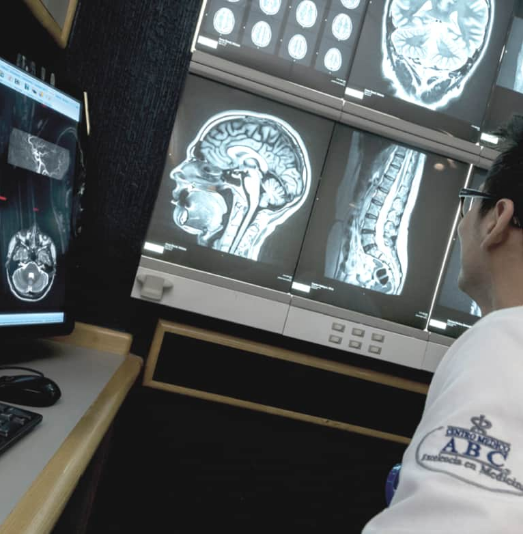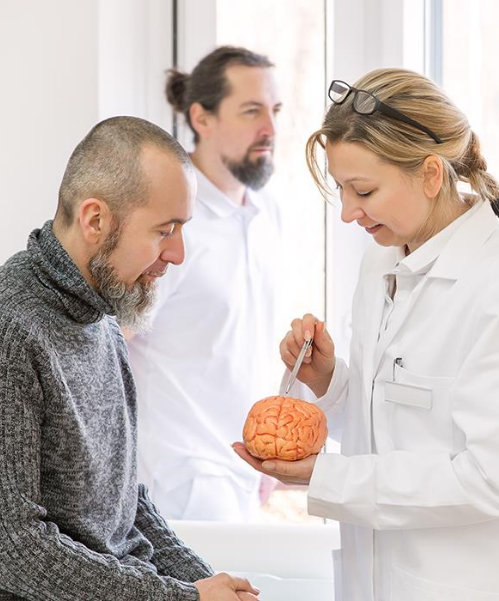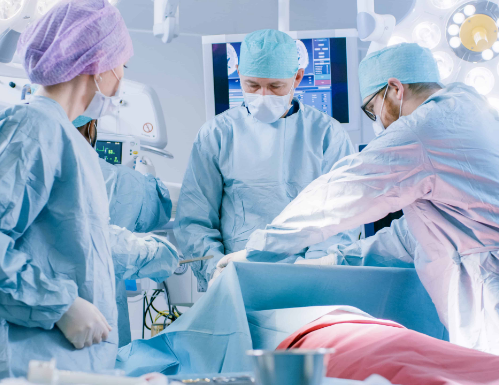Neuro Oncology

The Neuro-Oncology Program at the Centro Médico ABC Neurological Center provides state-of-the-art treatment for patients with nervous system tumors (malignant and benign), including brain and spine. Our team provides expert care for patients experiencing neurological complications from cancer, cancer therapies, or related disorders. Our qualified and experienced physicians participate in a multidisciplinary approach to the management of diseases involving the brain and spine.
Brain tumors
What is a tumor?
The vast majority of cells in the body have a life cycle, so, similar to what happens with a living being: they are born, multiply and die. Cell multiplication is called mitosis and is carried out by the genetic information found in their nuclei. This mitosis follows a strict balance, whose primary objective is to repair and regenerate some damaged organs. However, there are times when this cell division is carried out in an excessive way, which generates the appearance of defective cells, which accumulate and form a mass or tumor.
How many types of tumors are there?
Generically, tumors can be classified into primary and secondary. Primary tumors originate in the cells of a certain organ, while secondary tumors (also called metastases) arise in a different organ.
Another way to classify them is by their behavior as benign and malignant. The difference between the two is the speed with which its cells multiply. This means that, in malignant tumors, cells divide more frequently, so they grow rapidly, unlike benign tumors, where the rate of cell multiplication is slower, and the growth of tumors can take several years.


What are the symptoms of a brain tumor?
The most frequently reported symptoms in brain tumors are:
- Headache: Which is usually progressive in intensity and frequency, which initially subsides to medications, but gradually does not. This pain tends to be constant, throbbing, and sudden. The location of the pain is not necessarily at the site of the tumor.
- Seizures: Which are commonly known as epileptic seizures and are characterized by sudden flexion and extension movements of the arms and legs, either localized (in one limb) or generalized (in all four limbs), which can be accompanied by loss of consciousness or not.
- Loss of any neurological function: Double vision, blurred vision, deafness, blindness, difficulty speaking, deviation of the mouth, drooping of an eyelid, weakness or inability to move any limb(s), problems passing food, agitation or depression.
- Others: Dizziness, vertigo, nausea, and vomiting.

What are the most common primary brain tumors?
Primary brain tumors are named for the cells that comprise them and the most common are meningiomas and gliomas. Meningiomas originate in the meninges, that is, in the membranes that cover the brain and spinal cord. They are benign tumors and therefore slow growing. This often allows them to go unnoticed for a long time, since the brain tends to “adjust and get used to” the presence of the tumor, so that initially they give very few or no symptoms and it is not uncommon that when they are diagnosed they have reached great dimensions.
Gliomas originate in glia cells, elements that serve to keep neurons together and protected. The most common form within this group of tumors is called astrocytoma, since it originates in astrocytes, a specific type of glial cell. According to the World Health Organization, astrocytomas are classified into four grades, depending on the rate of multiplication of its cells. Grades I and II are considered slow growing, while grades III and IV are fast-growing or malignant.
How can you tell the specific type of a brain tumor?
Diagnostic certainty is established only by histopathological study of the tumor. In other words, a fragment must be taken to be analyzed under the microscope by a specialist and precisely define the type of tumor that is being treated. Imaging studies: radiography, tomography, magnetic resonance, positron emission tomography (PET), only indicate the presence of the tumor and suggest a possible diagnosis, but this is established only until it is analyzed in the Pathology laboratory.
What is the treatment for brain meningiomas?
Because they are slow-growing tumors, not all of them require treatment. Those that are small and located in areas that do not affect neurological functions, can be kept under close surveillance. But when these grow or are located near functional areas of the brain, it is advisable to treat them. In ideal conditions, the best option is surgery, since this achieves the extraction of the lesion and, therefore, a better control of the disease. However, when these tumors are in difficult surgical access sites and are less than 3 cm in size, they can be treated with a targeted radiation system known as Radiosurgery.
What is the treatment for astrocytomas?
The vast majority of astrocytomas have to undergo surgery. However, in tumors that are located in functional areas of the brain, especially in the deeper parts of the brain (thalamus) or in a structure called the brain stem (located in the lower part of the brain), surgery may be very risky, so it is only indicated in selected cases.
Grade I astrocytomas that can be completely removed surgically usually no longer require further treatment. On the other hand, grade II, III, and IV astrocytomas, in addition to surgery, have to undergo radiotherapy and chemotherapy, even though they have apparently been completely removed with surgery. This is because these tumors are rooted, and these treatment modalities (called adjuvant) are indicated to control them.



What are the consequences of having surgery for a brain tumor?
Although every medical act involves a risk, today there is a great technological development that has notably increased safety in the treatment of brain tumors. Possible impairments in brain function that occur after surgery depend on the specific location and size of the tumor. Techniques such as microsurgery, endoscopy, neuronavigation, stereotaxy, awake patient surgery, intraoperative neurophysiological monitoring, among others, have contributed to improving results in this field, achieving greater control of the disease, with an excellent quality of life for patients.
Do brain tumors metastasize?
It is extremely rare for a brain tumor to cause (secondary) tumors in other organs.
Once a brain tumor is treated, can it grow back?
Yes, all tumors, no matter how benign and even when they have been completely removed and successfully subjected to adjuvant treatment (when this is the case), have the risk of reappearing. That is why the control by the specialist should be carried out indefinitely.

What are the most common secondary (metastatic) brain tumors?
The most common brain metastases originate from tumors of the lung, breast, kidneys, lymphatic tissue, digestive system, and skin.
What is the treatment for secondary tumors or metastases?
The most important thing in these cases is to control the tumor of origin (primary tumor), by an Oncology specialist. When the metastases are large and, in a place, accessible for surgery, it is best to remove them. Otherwise, they must undergo other options such as radiosurgery, radiation therapy, or chemotherapy.

Our Locations
At ABC Medical Center, we are prepared to serve you in out two Campuses 24/24h, 7 days a week.
Campus Santa Fe
Av. Carlos Graef Fernández 154, Col. Santa Fe,
Cuajimalpa, 05300, Cd. de México.
Tel. 55 1103 1600
Campus Santa Fe
Av. Carlos Graef Fernández 154, Col. Santa Fe,
Cuajimalpa, 05300, Cd. de México.
Tel. 55 1103 1600

